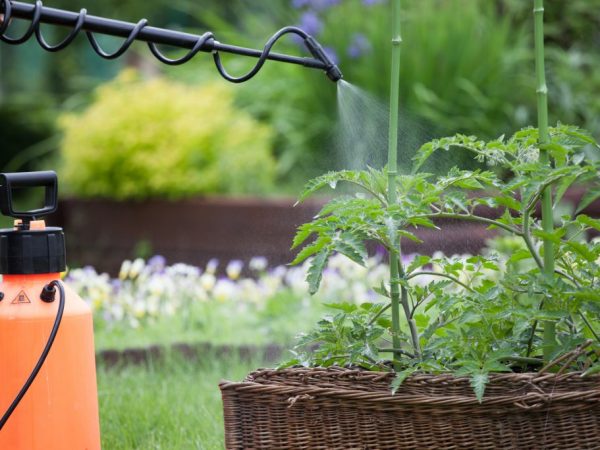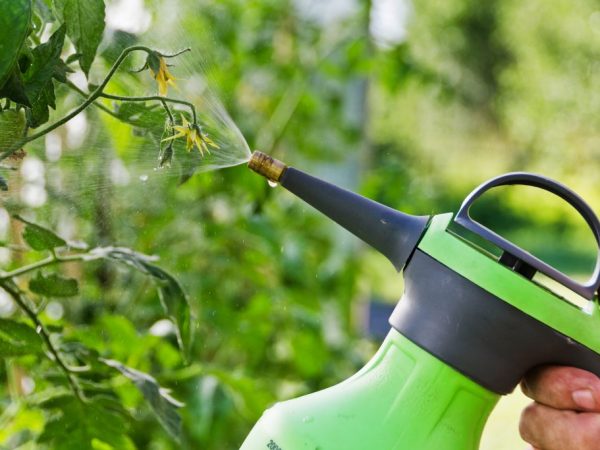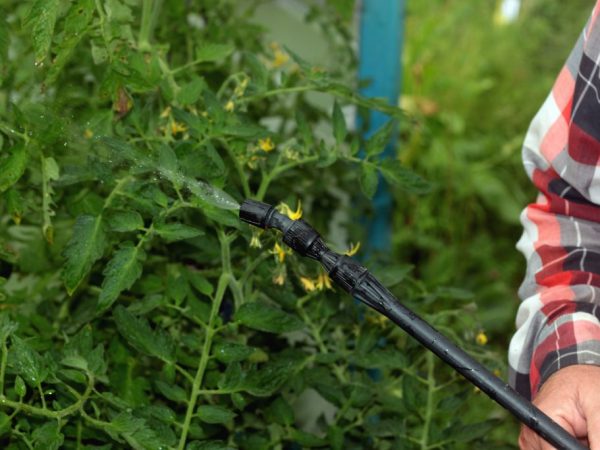How to carry out foliar feeding of tomatoes
For tomatoes to grow healthy, strong and robust, proper care must be taken. And one of these important elements is foliar feeding of tomatoes. It is often much more useful than fertilizing the soil. Since it gives the result already in the first hours after processing.

Foliar feeding of tomatoes
The benefits of foliar dressing
Experienced gardeners know that plants take nutrients not only from the soil. They can also absorb nutrients from the leaves. And tomatoes do it very well. With a lack of trace elements, dampness or drought, fungi, as well as temperature extremes, foliar feeding of tomatoes can help. After all, all trace elements are delivered directly inside, which significantly reduces the time.
Foliar dressing of tomatoes is effective throughout the growing season. Spraying perfectly strengthens the seedlings, subject to alternation with root feeding of tomatoes.
Indicators for foliar dressing:
- soil acidification;
- dense soil with poor absorbency;
- the beginning of flowering;
- damage to the roots;
- seedling disease;
- stagnation of water in the soil.
It is very important to observe the concentration of substances in the solution. It should not exceed 1%.
Step-by-step instruction
Use a spray bottle to top up the tomato. Choose its type and volume depending on the area of the sprayed area. And also prepare the dishes for the dilution of the composition and the necessary ingredients.
Sequence:
- inspect the trunk and leaves, determine the required composition of the spray solution;
- prepare the mixture;
- in the evening or on a cloudy day, we carefully spray the tomato from top to bottom.
Carry out this treatment starting with the germination of the seeds and until the first fruits are set. After the beginning of fruiting, it is advisable to apply fertilizers to the soil.
Feature of foliar feeding
Each greenhouse has its own microclimate. Therefore, you need to closely monitor the condition of the tomatoes. Since the slightest changes in shape and color are the first indicators of a deficiency of useful micronutrients and the development of diseases.
Foliar feeding of tomatoes in the greenhouse is carried out less frequently than in open beds. They are only needed to support the tomato and prevent disease. A solution of copper sulfate or Fitosporin is very suitable for this.
Spray your plantings in the morning. At this time, the greenhouse has not yet warmed up and the evaporation in it is not so intense.
Spraying in the open field

Spraying will help fight pests
In the open field, process the tomatoes immediately after planting the seedlings. Because the roots are damaged and the seedling needs additional nutrition for quick recovery and adaptation. Spraying tomatoes gives its results as soon as it is absorbed.Even if the leaves have withered a little or a fungal disease has appeared, such treatment can quickly cope with it.
The solutions for spraying in the open field and in the greenhouse are the same. The composition is based on water with the addition of:
- boric acid;
- superphosphate;
- urea;
- wood ash;
- iodine;
- calcium nitrate.
Boric acid
Boric acid is very easy to find and purchase. It is a very active trace element and is involved in a variety of vegetation processes. Its deficiency is manifested by a decrease in the number of fruit formation. The leaves turn light green, curled. The growth point turns black.
After spraying with boric acid, the seedlings become more disease-resistant. To combat diseases, it is often combined with treatment with a weak solution of potassium permanganate.
Boric acid solution preparation:
- for seedlings in 1 liter of hot water add 1 gr. boric acid, stir, cool slightly;
- for adults, dilute tomato in 10 liters of hot water with 1 teaspoon of powder.
Observe the proportions strictly. Process from all sides of the sheet in the morning or evening.
Superphosphate
The use of superphosphate significantly increases the yield of tomato. They are processed to increase the number of ovaries and accelerate fruit ripening.
To improve the result, add urea and potassium chloride to superphosphate. Prepare the composition according to the instructions.
Urea
Urea (urea) is a fertilizer with a high nitrogen content. With a lack of nitrogen, the plant leaves and ovaries fall off, growth slows down. Tomatoes become pale green, bloom poorly and bear poor fruit. To replenish this trace element, spray with a solution consisting of 50 g. urea and 10 liters of water.
Treat tomatoes with urea only when necessary. Urea cannot be used during flowering.
Wood ash
Wood ash is used not only as a source of nutrients, but also as an effective means to fight diseases and parasites.
For foliar feeding, use a solution of 2 liters of ash, 10 gr. boric acid and 10 liters of hot water. Insist 3-4 hours, strain.
For pest control, mix 2 liters of ash, 50 gr. household soap and 10 liters of hot water, cool and strain.
Iodine

Iodine solution will increase immunity
Carry out foliar feeding with iodine to accelerate plant growth, increase immunity, and increase fruiting.
In order not to harm, observe the proportions of iodine. Dilute 5 drops of iodine in 1 liter of milk. Spray with a fine spray, as large droplets can burn.
Calcium nitrate
Calcium nitrate or nitrogenous calcium acts more mildly than urea. Spraying with it is done to quickly increase green mass, increase disease resistance, increase fruiting and improve the taste of tomatoes.
Process after transplanting seedlings into the ground.
Dilute the solution according to the instructions: 2 gr. saltpeter per 1 liter of water. Spray at the rate of 1 liter of solution per 1 bush.
Processing during flowering
To prevent flowers from dropping and reduce ovaries, it is necessary to spray tomatoes with a solution of boric acid every decade.
To increase the ovaries and strengthen the immune system, spray with solutions:
- dilute 1 teaspoon of superphosphate in 10 liters of hot water, cool;
- chop 500 g of young nettle, add 10 liters of water, leave for 24 hours, strain.
The finished drug Ovary has proven itself well; you can buy it at a gardening store. Use as directed.
Using urea for foliar feeding during flowering can significantly reduce the number of ovaries.
Processing during ripening
Formation and ripening of fruits is the most difficult period for any crop. Use phytosparin to support tomatoes. Dilute it strictly according to the instructions.
Pay attention to the appearance of the fruit, this will help determine the cause of the disease:
- Lack of nutrition is manifested by changes in the appearance of the plant. Because of this, diseases often develop. To prevent disease, try to closely monitor the plantings more often.
- With a lack of calcium nitrate, dark depressed spots appear on the fruits, and the leaves curl. The defeat begins with apical rot. Treat the bushes with a solution of 2 grams. calcium nitrate per 1 liter of water.
- With a lack of nitrogen, the tomato plant sharply slows down growth or stops altogether. Use a weak urea solution for the treatment.
- Lack of phosphorus is manifested by darkening of the leaves, acquiring a purple hue with dark veins. Treat the tomatoes with a superphosphate solution.
Spraying rules
- Spray with a warm solution. If tomatoes are treated with cold water, they can experience a shock from the temperature difference and become covered with small spots.
- The air temperature during processing should be within 20˚-25˚C. If it is higher, then the solution dries quickly and does not have time to be absorbed. At low temperatures, humidity rises, which can lead to decay.
- First, test the solution on 1-2 tomato bushes, wait a couple of hours. In the absence of negative consequences, spray the entire area.
- When processing tomatoes with a spray, try not to exceed the dosage of nutrients, as this can lead to burns on the leaves.
Perform procedures such as foliar feeding of tomatoes only when necessary. The oversaturation of the tomato with nutrients leads to disruption of normal growth, an increase in green mass and a decrease in yield.


